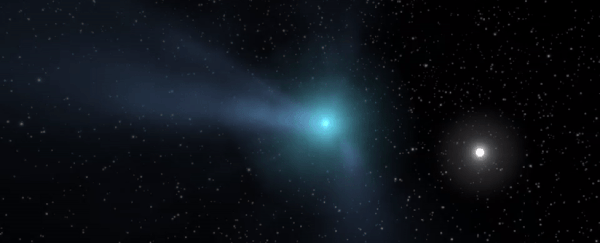In the Solar System, there are over 6,300 known comets. There are millions of asteroids. And of all those objects, only 'Oumuamua - a red, cigar-shaped asteroid - is known to have come from elsewhere. Until now.
A new discovery, revealed just last week, has astronomers excited. A comet named C/2019 Q4 (Borisov), discovered on August 30 by Crimean amateur astronomer Gennady Borisov, has a trajectory and velocity that suggests the object originated outside the Solar System.
Eager telescopic eyes have been turning to the comet's location to try and extract as much information as humanly possible. Late last week, we got our first full-colour photo, showing the distinctive outgassing associated with an icy cometary body drawing closer to the Sun.
And now the first pre-print papers are coming in. Two separate teams have analysed the comet so far: one looking at the object's colour, and another one at its spectrum, to see if they could learn more about the composition of the strange body. Their work is yet to be peer-reviewed, but we can start looking at their findings along with the scientific community.
Comets and asteroids are two distinct types of space object. Asteroids are large chunks of rock and metal. Comets are made of ice and rock; when they travel close to the Sun, the warmth produces a cloud of vapour and dust around the comet, which also trails away from the heat source, creating the famous cometary tail.
('Oumuamua is a weirdo that exhibits characteristics of both a comet and an asteroid; or, possibly, neither. The jury is still out.)
We know what comets are like in the Solar System - the kinds of gases they emit, their size. We even know a little bit about exocomets orbiting alien stars.
For example, comets have been detected orbiting the star Beta Pictoris; as the comet passes between us and the star, the quality of the star's light changes according to the chemistry of the comet. Those exocomets are a lot like our comets.
But an interstellar comet would be a data point we could study up close - seeing how similar or different it is to our home-grown comets could tell us more about the Solar System itself.
If the comet is similar, that indicates other planetary systems may be made of the same stuff as our own; but a really different composition and behaviour could give us clues to other planetary system blueprints.
Based on the two papers so far, C/2019 Q4 (Borisov) is looking a lot like our Solar System comets. The first paper is led by Piotr Guzik and Michal Drahus of the Jagellonian University in Poland, and found on arXiv; the other is led by astronomer Julia de León of the Instituto de Astrofísica de Canarias, and published on the Institute's website.
Guzik and colleagues based their conclusions on the optical data obtained by the William Herschel Telescope and Gemini North telescope. They analysed the red and green magnitudes and found that the comet's colour - very green and not very red - is essentially the same as Solar System long-period comets that originate in the Oort Cloud.
De León and colleagues studied the comet using the Gran Telescopio Canarias, obtaining three visible spectra of the comet using the OSIRIS instrument to analyse its chemical composition. These also showed that the comet is similar to Solar System long-period comets.
"We computed the spectral slope in the 0.55–0.90 µm range, S' = 10 ± 1 %/1000 ˚ A, which is roughly in the middle of the range of visible spectral slopes observed for cometary nuclei and asteroids in cometary orbits," they wrote in their paper.
"This suggests that comets formed in other stars [sic] can have a similar composition to those formed in the Solar System and thus be likely produced by similar processes."
There are a few things we have yet to ascertain. We don't know, precisely, how big it is - images of comets are fuzzy because of the outgassing, which makes measuring the actual rock inside difficult.
Observations so far suggest it's somewhere between 2 and 16 kilometres (1.2 and 10 miles) in diameter. That's a lot bigger than 'Oumuamua's 170 metres.
The comet's origin is also yet to be verified. That will likely take months of observations, carefully plotting the object's path across the sky to get a clearer understanding of its trajectory.
Unlike 'Oumuamua, though, which was only discovered when it was already on its way back out of the Solar System, C/2019 Q4 (Borisov) is still heading inwards. It will, astronomers believe, reach perihelion - its closest approach to the Sun - around 8 December 2019.
We can't wait to see the pictures.
The pre-print papers can be found on arXiv and the IAC website.
